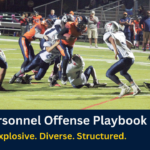Running Inside Zone with a Tight End

Tight Ends present all sorts of issues for defensive coaches. One of the main issues that they bring up is that the defense now has to defend an extra run gap. Whether this is on the front side of the Inside Zone scheme or the backside of the Inside Zone scheme and can create a great surface for the offense to gain a numbers advantage.
Running Inside Zone with a Tight End
One thing we really enjoy doing is using a Tight End on the frontside of the Inside Zone scheme. We like to keep our rules very simple so he will keep the same rules as the Offensive Line meaning that he will be responsible for his playside gap. If there is a defender in his outside gap (which most defenses like to have to stop the outside run) he is going to block him out. His rule is that the defender cannot cross his face. If there isn’t a defender on the line in his outside gap he will look to help his buddy by doubling the C Gap defender. While he doubles the C Gap defender, he is still responsible for his playside gap. This means that if there is any linebacker or safety blitzing through this gap he will come off and keep that blocker outside.
We also like using a Tight End on the backside of the Inside Zone scheme. There are really two different ways we can use this blocker. Our base way of blocking Inside Zone with a Tight End on the backside is to keep him responsible for his playside gap. This tends to work well if we have a Quarterback who is not much of a running threat. In this case he is going to take the C gap defender and move him vertically. If there is not a defender on the line in the C gap he will climb up to the next level and look for a linebacker to block. In this our base way of blocking Inside Zone with a Tight End, because the C gap defender is going to be blocked, the Quarterback will always be handing the ball off.
Related Content: How to Utilized a Tight-end in Your Offense
If we have a running Quarterback, we can give our Tight End an Arch call. This Arch call means that he will not be blocking the C gap defender and block the first threat outside of the C Gap player. This would allow the Quarterback to read the C gap defender and have a lead blocker in the event that he gets a pull read. This can be especially deadly on an even front defense if it is run to the boundary.
Inside Zone is a great offensive blocking scheme that uses simple rules to create vertical push on defensive linemen. By adding in a Tight End, the offense can add an extra blocker into the box and outnumber the defense to create better matchups.











